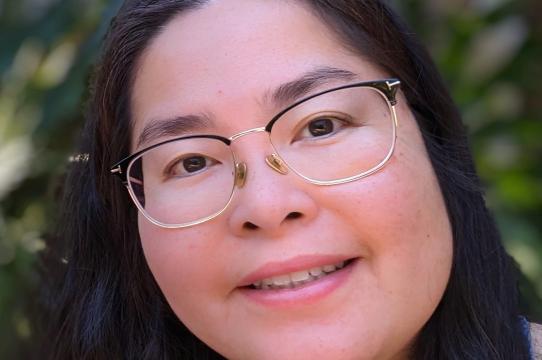Yi Yi Mon (Rosaline) Kyo is very happy to be a new assistant professor of History of Art and Visual Culture at UC Santa Cruz. She’s pleased to be back in California near her family. And Kyo, whose research focuses on modern and contemporary from Tibet and China, as well as the visual construction of race, ethnicity, and gender in Asia, admires her new department colleagues and their approach.
“They use decolonial methodologies, challenging what people assume about museum and exhibition practices and also thinking through the traumas of the colonial and imperialistic past,” Kyo said. “That’s relevant to how I want to approach my work and how I have been trying to approach my own work. It's really exciting to be able to work with them.”
Kyo grew up in Sacramento, moving there from Burma with her family when she was eight years old. Although she thought the city was fairly diverse, she didn’t have an opportunity in high school to study Asian art or take any Asian languages. So, when she got to Carleton College in Minnesota, she designed her own major in Asian Studies, taking Buddhist art, the only art class that didn’t have a European focus. She also took Mandarin Chinese, which was a little challenging due to the schedule — two years of getting up to get to her 8 a.m. class Monday through Friday.
But it was worth it. After studying abroad in Beijing and Hong Kong Kyo continued to study Chinese art history, and was interested in the intersections between politics and visual culture. For her senior thesis, she wrote about how artists from the late Ming period \ subversively expressed their discontent at the new dynasty, a topic her advisor had touched on in a Chinese painting seminar.
At UC Santa Cruz, Kyo will be teaching East Asian art history and visual culture, proposing several new courses for the coming year, including Art and Propaganda in 20th century China.
“We'll be covering modern and contemporary Chinese art in the 20th century, starting from the Opium Wars, moving onto the nationalist movement t under the socialist regime, and then during the experimental period in the 80s, and 90s,” Kyo said. “The other course is an intro course, a survey of early East Asian visual cultures, starting from the Neolithic period in China, Japan and Korea all the way into the period when Buddhism takes hold in all of these countries.”
Kyo had been teaching at Davidson College in North Carolina, and she is happy to be in the Bay Area with the wealth of Asian Art here, including Stanford University’s Cantor Art Center’s Asian American Art Initiative, the Asian Art Museum in San Francisco, and the Berkeley Art Museum and Pacific Film Archive, where Kyo did a postdoc after getting her Ph.D. in Art History at UC Berkeley. Recently, she guest curated a show at BAMPFA, Endless Knot: Struggle and Healing in the Buddhist World, which was on view from December 2022 to May 2023.
Along with extensive background in the arts, Kyo earned a master’s degree in special education from Loyola Marymount University and taught in the Los Angeles Unified School district. She says her teaching philosophy and pedagogical approach to teaching higher education borrows heavily from what she learned as a special education teacher.
As well as being looking forward to working with her new colleagues, Kyo says she wanted to be at UC Santa Cruz because of the diversity of the student population and the university’s commitment to providing education for all students. She enjoys advising and mentoring students from diverse backgrounds and looks forward to working with graduate students at UC Santa Cruz.
10/2/2023


